The Snapdragon 845 Performance Preview: Setting the Stage for Flagship Android 2018
by Ryan Smith & Andrei Frumusanu on February 12, 2018 12:30 AM EST- Posted in
- Mobile
- Snapdragon
- Qualcomm
- Smartphones
- SoCs
- Snapdragon 845
System Performance
To see how the new CPUs and memory subsystem translate into more real system performance, we move onto more representative tests such as PCMark. PCMark’s performance is affected by several factors: not only does raw performance of the hardware count but also we need to consider the individual system’s software stack. We’ve seen large differences between Android OS major versions where the improvements of the Android Runtime can be directly visible in subtests such as the Writing test. Also a SoC’s DVFS schemes and schedulers can have huge impacts on “performance-latency”, meaning how fast the CPUs can ramp up a workload. This directly translates in a lot more performance in several of PCMark’s subtests as in the default settings none of the tests actually represent the pure performance of the CPU if it were locked at maximum frequency on the performance cores. The results of the tests are also overall a good representation of “snappiness” of a device.
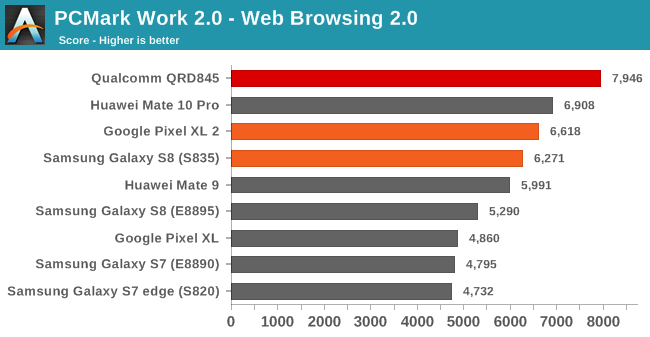
In the web browsing test the Snapdragon 845 QRD manages to outpace the Pixel 2 XL by 20%. Here we’re also looking at performance across devices with different OS versions. The Google devices are running Android 8.1 while the Samsung devices were tested with Android 7.0. The Mate 10 Pro runs Android 8.0 while the Mate 9 still had 7.0. The Qualcomm QRD we tested ran Android 8.0.
Again the performance increase over Snapdragon 835 devices isn’t all that great. DynamiQ allows for far more efficient thread transitions between the CPU cores and subsequently I expected Qualcomm to take advantage of this through more aggressive scheduling resulting in more than just a 20% increase. The difference between the Mate 9 and Mate 10 here is a good example of what a software configuration change can bring in terms of performance (both devices employ same performance CPU configurations). Samsung’s Exynos’ SoCs still use GTS scheduling and have non-optimal performance-latency resulting in bad scores, amplified by the fact that Samsung’s memory performance is also underwhelming when compared to the Snapdragon and Kirin SoCs.

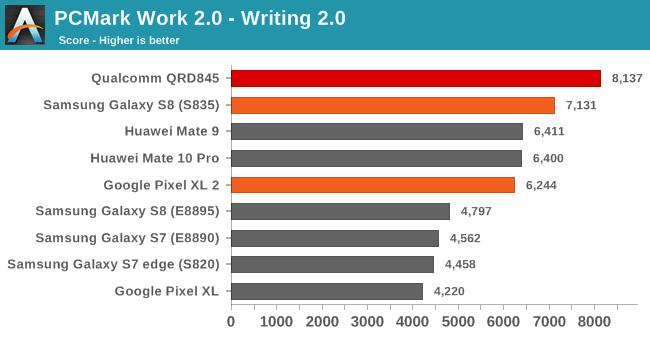
The Data Manipulation and Writing 2.0 tests make heavy use of the Android runtime and APIs and also a very memory latency sensitive. Between the best showings of the Snapdragon 835 variant of the S8 and the Pixel 2 XL in each respective benchmark, the Snapdragon QRD845 showed conservative increases of 8 to 14%. The Exynos SoCs lacklustre performance is again hampered by software and by bad memory performance.
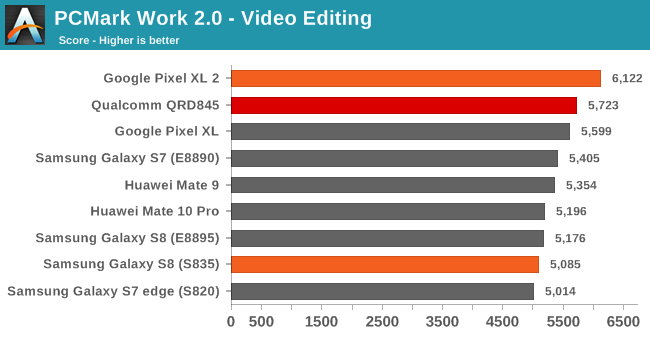
The video editing test is PCMark’s weak-point as it’s bottlenecked by things such as OS API overhead, and why we see tight grouping of performance results across a large range of SoCs. The Snapdragon 845 ends up high, but below the Pixel 2 XL. I would not put much weight on the results of this test as they’re not necessarily representative. Futuremark claims that the test is a lot more sensitive in mid- and low-range devices which can exhibit performance issues.
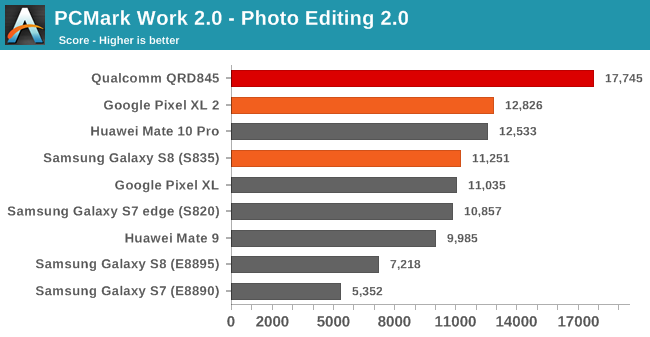
The photo editing test makes heavy use of Renderscript and use GPU acceleration to apply various effects on an image set. The QRD845 here shines as it’s able to showcase a 38% performance improvement over the Pixel 2 XL. Again the test not solely tests the raw performance of the system but also how optimized it is in terms of the software stack. This can be seen in the Kirin vs Exynos devices as Huawei’s phones vastly outperform Samsung’s devices in this test.
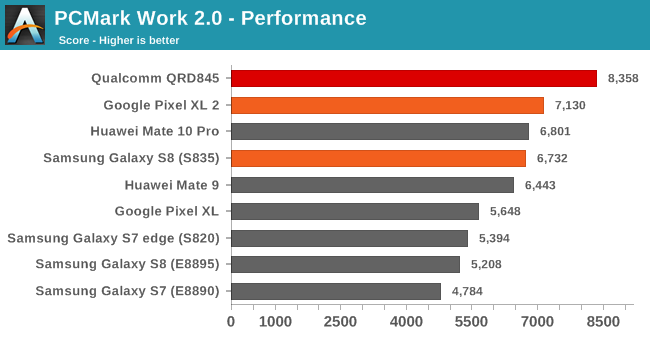
Overall PCMark’s performance score for the QRD845 increases by 17% over the Pixel 2 XL. Disregarding the video test, we see a similar scenario as in the synthetic tests as the new SoC’s CPU performance increases are lower than we had expected. Still the Snapdragon 845 is able to top the charts and should adequately power 2018’s flagship devices.
For 2018 we are reviewing our mobile benchmarking suite and altering some of the benchmarks we use. One of the changes in the way we benchmark devices is that we’re moving away from standalone browser and rather are benchmarking the OS’s WebView implementations. In general this seems to be a better choice for testing device experience as there is a lot of content that is being consumed via WebView windows. We also avoid the argument about different browser performance and since Google has now made WebView an updatable Play Store component we should also have valid comparisons older devices and systems. On the iOS side we do the same as we now benchmark browser tests within a WkWebView shell.
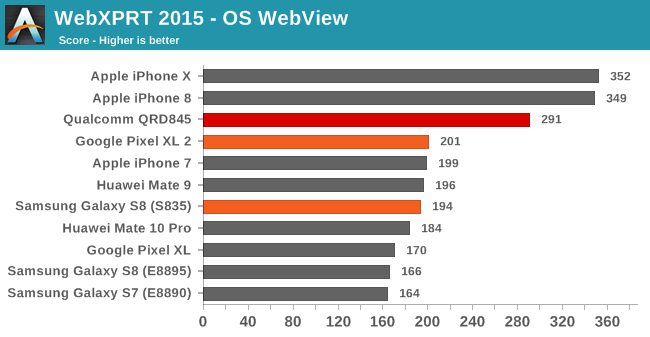
Starting off with WebXPRT 2015 for a last time before we’ll retire it in favour of WebXPRT 3, we see the QRD845 performing fantastically. Here the 44% performance increase over the Pixel 2 XL is a lot more in line with what we had expected of the new SoC. The QRD845 is even able to catch up a lot with Apple’s newest A11 and Monsoon cores in this test.
To keep up with the ever changing landscape of the developing web, we’re also retiring past JavaScript benchmarks in favour of a brand new and more representative benchmark developed by the WebKit team and welcomed by Google; Speedometer 2.0.

Here the Snapdragon 845 showcased another healthy performance increase of 37% over the Snapdragon 835 devices. Apple’s superior JavaScript performance can be attributed to a much faster and more optimized Nitro engine while Google’s V8 has only seen meagre improvements over the years. Notable is the Apple A11’s massive performance jump over the A10 – vastly increasing the distance to Android devices.










140 Comments
View All Comments
North01 - Monday, February 12, 2018 - link
"When we’re looking at competitor devices we see only the the iPhone X able to compete with the last generation Snapdragon 835 devices – however with a catch. The A11 is severely thermally constrained and is only able to achieve these scores when the devices are cold. Indeed as seen from the smaller score of the iPhone 8, the SoC isn’t able to sustain maximum performance for even one benchmark run before having to throttle."I was curious about that, as the iPhone X has a lower score on Futuremark's website.
Futuremark:
https://www.futuremark.com/hardware/mobile+sling_s...
3DMark Sling Shot Extreme Unlimited
iPhone X (A11)
Average score: 3175
Physics score: 2206
Graphics score: 3625
iPhone 8 (A11)
Average score: 2802
Physics score: 1988
Graphics score: 3166
Pixel 2 (Snapdragon 835)
Average score: 3531
Physics score: 2951
Graphics score: 3723
The Snapdragon 845 is looking to be rather impressive, hopefully we can find out more about its sustained performance when it launches in upcoming devices.
Matthmaroo - Monday, February 12, 2018 - link
Yes but A11 was already deployed , by the time this soc is in the hands of people - A12 will be a factorGood on Qualcomm for catching up but still 6 months to a year behind
North01 - Monday, February 12, 2018 - link
I'm a bit confused by your comment. The comparison was between the Snapdragon 835 (H1 2017) and the A11 (H2 2017).Commodus - Monday, February 12, 2018 - link
I believe he was referring to the 845 comments at the end. And this is the usual yearly concern: people wax ecstatic, thinking Qualcomm has finally caught up to or beaten Apple... and forget that the phones with the new chip are shipping half a year later (or longer) after Apple's, so any advantage is short-lived.vanilla_gorilla - Monday, February 12, 2018 - link
That's an interesting perspective. Couldn't you just as easily say that any time an iPhone is launched with a new SoC it's advantage will be short lived as the next Qualcomm SoC will be faster? It seems to me they're just leapfrogging each other each time.Matthmaroo - Saturday, February 17, 2018 - link
So the next gen Qualcomm chip gpu beats apples last gen tech.6 months from now we will have a phone with the 845 and 7 months from now we will have the A12 - that’s the actual comparison
Huge win
They still can keep up with apples single thread performance.
ciparis - Sunday, February 18, 2018 - link
"So the next gen Qualcomm chip gpu beats apples last gen tech."Except it doesn't -- not remotely. Qualcomm is reliably 2-3 generations behind in performance of flagship phones.
Santoval - Tuesday, February 20, 2018 - link
Which review did you read (if you read any)?lilmoe - Monday, February 12, 2018 - link
The A11 isn't, in any way, superior to the SD835 for mobile. Get this through your heads people. Have you been under a rock? Haven't you been reading about the failures of Apple's core architecture? What else do you want as proof?SMH....
neoncat - Tuesday, February 13, 2018 - link
<Kevin Bacon in Animal House>REMAIN CALM!! ALL IS WELL!!!!!
</Kevin Bacon in Animal House>